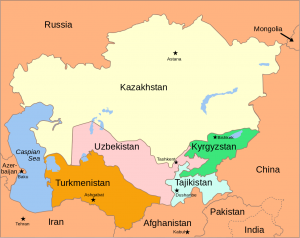The World Bank Europe and Central Asia regional forecast
January 2016
In the Europe and Central Asia region, economic growth is projected to rise to 3 percent in 2016 from 2.1 percent in the year just ended as oil prices fall more slowly or stabilize, the Russian Federation’s economy improves, and Ukraine recovers, according to the January 2016 issue of Global Economic Prospects. Growth over the 2016-18 forecast period could pick-up modestly in the eastern part of the region, which includes Eastern Europe, South Caucasus, and Central Asia, supported by a gradual stabilization of commodity prices and more favorable economic spillovers from the Russian Federation as its recession bottoms out and growth returns. The western part of the region, which includes Bulgaria, Romania, Turkey, and the Western Balkans, should grow moderately in 2016, buoyed by recovery in the Euro Area.
Regional Economic Prospects in EBRD Countries of Operations
November 2015
The outlook for growth in the EBRD region in 2015 and 2016 has remained broadly unchanged since our last forecast in May.1 On current projections, 2015 will be the fifth year of consecutive slowdown in average growth – from 4.6 per cent in 2010-11 to 0.2 per cent in 2015. Growth is expected to pick up modestly in 2016, recovering to 1.6 per cent.
These numbers reflect divergent trends in different sub-regions. The sharp drop in the price of oil and other commodities and a recession in Russia, where output is projected to contract by 4.2 per cent in 2015 and 1.2 per cent in 2016, weigh on the growth outlook in the Eastern Europe and the Caucasus (EEC) and Central Asia regions. Ukraine’s economy will suffer a double-digit contraction this year but is expected to return to growth in 2016.
Growth and financial stability in Central Asia in 2015 have been significantly affected by the recession and currency depreciation in Russia and lower prices of oil and other commodities. At the same time, FDI and financial support from China and Russia, and to a lesser extent Western investors and IFIs, are increasingly contributing to growth and financial stability in the region. Growth in Kazakhstan, the largest economy in the region, is sharply lower, due to the collapse of the oil price, and to a much lesser extent, the negative effect of an influx of cheap imports from Russia on domestic industries and spillovers of negative investment sentiment from the Russia/Ukraine crisis. Tajikistan, the Kyrgyz Republic and, to a lesser extent, Uzbekistan, have been hit by sharply declining remittances from Russia, with growth supported by FDI and financial assistance from China and Russia. Growth in Mongolia remains subdued due to sharply lower FDI and weak commodity prices, and, to a lesser extent, a slowdown in China. The currencies across Central Asia have weakened significantly, with double-digit depreciation in all counties during the course of 2015. Kazakhstan has switched from a peg to the US dollar to a flexible exchange rate regime with inflation targeting. Central banks have supported currencies through foreign exchange market interventions (at times, very significant ones), tighter monetary policies and, in some cases, administrative measures. The growth in the region is expected to remain subdued in 2016, compared to recently observed growth levels, due to low oil and other commodity prices and continued recession in Russia, and to a lesser extent due to slower growth in China.
Kazakhstan
In Kazakhstan GDP growth is projected to slow to 1.2 per cent in 2015, compared with 4.3 per cent in 2014, reflecting the plunge in oil prices, recession in Russia, depreciation of the rouble – which, particularly in the late 2014 and H1 2015, resulted in an influx of cheap imports from Russia, putting pressure on domestic industries and weaker exports – and weakening investor sentiment as a result of the Russia/Ukraine crisis. The slump in oil prices is significantly affecting profitability of the extractive sector and government revenues, which in 2015 is expected to lead to a budget deficit of around 3 per cent of GDP, with the government relying significantly on funding from the Wealth Fund and the National Pension Fund. The government has reacted with an acceleration of reforms and fiscal stimulus, which is providing a boost to growth. On August 20th, Kazakhstan switched from an exchange rate regime of a peg to the USD to a floating exchange rate regime with inflation targeting. The switch was expected but the timing was brought forward considerably, reflecting the government’s and National Bank of Kazakhstan’s view of an expected further decline in oil prices. By mid-October, the tenge had depreciated by more than 30 per cent against the US dollar. In the short run the depreciation is having a significant effect on some sectors and consumers, but overall its impact on growth is neutral. The difficult external environment and increasing pressures domestically will continue to affecting Kazakhstan in 2016, with growth expected to remain subdued and reach only 1.5 per cent. Inflation is expected to average 6.8 per cent in 2015.
Uzbekistan
Uzbekistan’s GDP growth is expected to decline to 7.5 per cent in 2015, compared with 8.1 per cent in 2014, reflecting a sharp drop in remittances from Russia and slowdown of economies of some of the main trading partners. The som has depreciated significantly over 2014 and 2015. Inflation is expected to reach 8.8 per cent in 2015, up from 8.4 per cent in 2014. In 2016, growth can be expected to reach 7.2 per cent, as external factors continue to weigh on remittances and trade. Macroeconomic vulnerabilities from the prolonged challenging external environment are increasing.
Kyrgyz Republic
GDP growth in the Kyrgyz Republic jumped in the first half of 2015 to 7.3 per cent, around double the 3.6 per cent rate recorded in 2014. The increase in growth came despite the significant downward pressure coming from sharply lower remittances from Russia and the more difficult export environment due to recession in Russia, depreciation of the Russian rouble and sharply slower growth in Kazakhstan. The increase was mainly driven by robust performance in gold production and the base effect from back-loaded production in the previous year. It was also supported by investment and financial assistance provided by Russia as part of the accession to the EEU. Sharply lower oil prices are also providing a boost to consumption and growth, since the country is a significant net oil/petroleum importer. GDP growth for the full year is expected to reach 5.0 per cent. The som has depreciated significantly in 2014 and 2015, notwithstanding the National Bank’s heavy interventions and gradual tightening of monetary policy; however, international reserves have declined to US$ 1.8 billion as of end-September 2015, covering around three months of imports. Inflation is expected to remain elevated at around 8.5 per cent in 2015 reflecting the exchange rate pass through. In 2016, growth is expected to decline to 3.9 per cent, reflecting the continued challenging external environment. Macro vulnerabilities, including from increasing NPLs, and fiscal and social pressures can be expected to increase, reflecting the legacy from lower remittances and returning migrants in 2015 and softer exports to Russia and Kazakhstan. The investment and financial assistance provided by Russia can be expected to remain an important factor affecting growth.
Tajikistan
In Tajikistan, GDP growth is expected to decline to 5 per cent in 2015, compared with 6.7 per cent in 2014, reflecting a sharp contraction in remittances from Russia as well as the return of many migrants. The negative effects of lower remittances are being mitigated by increased investment from China and, to a lesser extent, investment from other countries. The somoni has depreciated significantly in 2014 and 2015, contributing to a rise in NPLs, given the very high level of dollarization in the country. The Central Bank’s interventions in the foreign exchange market, as CENTRAL ASIA 29 well as administrative measures, have helped to limit depreciation, but that has come at the expense of losing a significant part of international reserves, which now stand at a very low level. Overall, the reduction in remittances, returning migrants and overall weakness of the economy heighten social security risks in the country. Inflation is expected to reach 6.4 per cent in 2015. Notwithstanding the fact that remittance flows from Russia might stabilise in 2016, the legacy of sharply lower remittances and returning migrants in 2015 as well as increasing NPLs can be expected to continue to weigh down on growth. GDP growth in 2016 is projected at 4.5 per cent, supported by expected strong FDI from China.
Turkmenistan
In Turkmenistan, officially recorded GDP growth is expected to decline to 8.5 per cent in 2015 from 10.3 per cent in 2014, reflecting lower oil and gas prices and an economic slowdown of the trading partners in the region. Turkmenistan has increased gas exports to China, mitigating the negative effect of Russia’s Gazprom decision, announced in the beginning of 2015, to cut gas imports from Turkmenistan. The Manat was devalued by 19 per cent at the beginning of 2015, which is helping to improve competitiveness, whilst also pushing up inflation to 6.9 per cent in 2015. In 2016, growth can be expected to remain at 8.5 per cent, supported by FDI both in the extractive and non-extractive sectors, as well as continued domestic investment into such sectors are real estate. Plans related to the Turkmenistan-Afghanistan-PakistanIndia pipeline are being finalised, with the work on the Turkmen part of the pipeline expected to start in late-2015 or early-2016, resulting in increased investment. Expected low oil and gas prices will continue put pressure on Turkmenistan’s fiscal balance and growth.
Mongolia
Growth in Mongolia slowed from double-digit levels in 2011-13 to 7.8 per cent in 2014 and is projected to decelerate to 3.3 per cent in 2015, as a result of lower FDI in the mining sector (due to the delays in several large mining projects, including the second phase of the Oyu Tolgoy (OT) project), lower commodity prices and weaker demand for commodities from China. Domestically, a slow-down in the real estate sector is also contributing to more subdued growth. The tugrik has depreciated significantly in 2014 and 2015, notwithstanding significant interventions of the National Bank in the foreign exchange market and gradually tightening monetary policy. Inflation is expected to remain relatively high, at around 8.2 per cent. The likely re-starting of the second phase of OT in late-2015, with significant investment expected in 2016 (and thereafter), can be expected to push up growth to a projected 5 per cent in 2016. The potential loosing of fiscal policy in 2016 in the wake of parliamentary elections that will take place in June 2016 could give a further short-term boost to growth.

